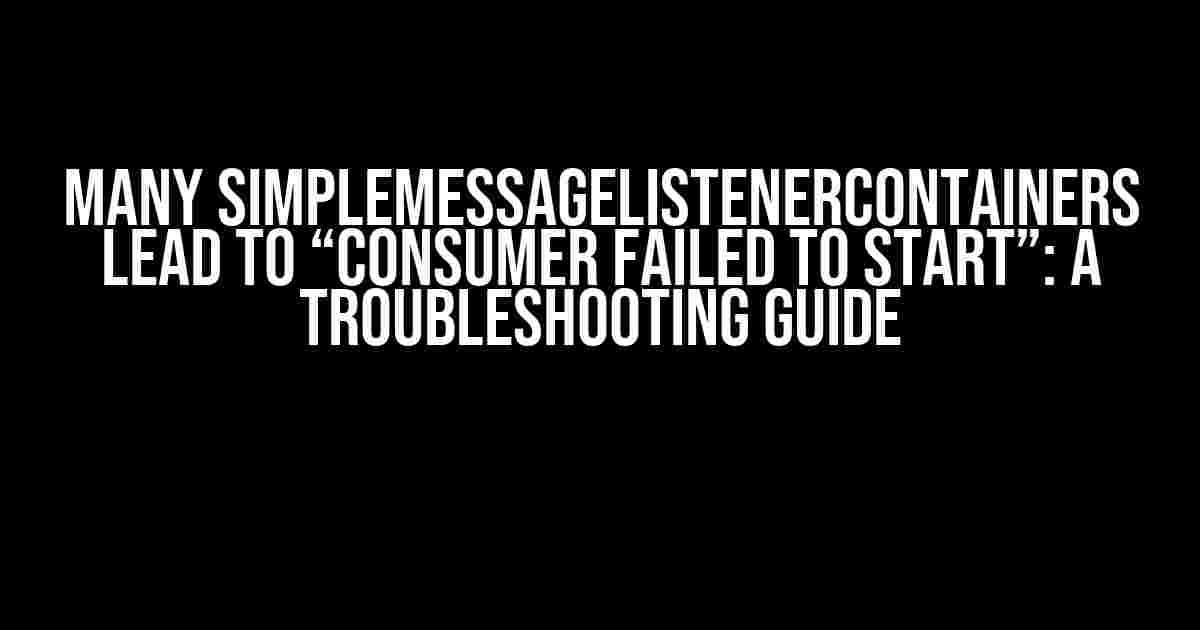If you’re using Spring’s SimpleMessageListenerContainer to consume messages from a messaging platform, you might have encountered the frustrating “Consumer failed to start” error. This issue can be caused by having multiple SimpleMessageListenerContainers, which can lead to a multitude of problems. In this article, we’ll dive into the reasons behind this error and provide you with a step-by-step guide to troubleshoot and resolve it.
Understanding SimpleMessageListenerContainer
The SimpleMessageListenerContainer is a powerful tool in Spring’s messaging framework, allowing you to consume messages from a variety of messaging platforms, such as RabbitMQ, Apache Kafka, and Amazon SQS. It provides a simple way to encapsulate message-driven POJOs, making it easy to write message-driven beans.
<bean id="listenerContainer" class="org.springframework.jms.listener.SimpleMessageListenerContainer">
<property name="connectionFactory" ref="connectionFactory"/>
<property name="destination" ref="destination"/>
<property name="messageListener" ref="messageListener"/>
</bean>
The Problem: Multiple SimpleMessageListenerContainers
When you have multiple SimpleMessageListenerContainers in your application, it can lead to conflicts and errors. This is because each container is trying to consume messages from the same messaging platform, causing the “Consumer failed to start” error.
Symptoms of the Problem
- The application fails to start, with an error message indicating that the consumer failed to start.
- Messages are not being consumed from the messaging platform.
- The application becomes unresponsive or hangs indefinitely.
Troubleshooting Steps
To resolve the “Consumer failed to start” error, follow these steps:
- Check the container configurations: Review your SimpleMessageListenerContainer configurations to ensure that each container is configured correctly. Verify that the connectionFactory, destination, and messageListener properties are set correctly.
- Verify the messaging platform configuration: Ensure that the messaging platform is correctly configured and that the necessary queues, topics, or exchanges are created. Check the platform’s logs for any errors or warnings.
- Check for conflicts between containers: Identify any potential conflicts between multiple SimpleMessageListenerContainers. Ensure that each container is consuming from a unique destination or queue.
- Use a unique clientId for each container: Ensure that each SimpleMessageListenerContainer has a unique clientId. This can help prevent conflicts between containers.
- Enable debug logging: Enable debug logging for the SimpleMessageListenerContainer and the messaging platform. This can help identify any underlying issues causing the “Consumer failed to start” error.
- Use a unique clientId for each SimpleMessageListenerContainer.
- Ensure that each container consumes from a unique destination or queue.
- Verify the messaging platform configuration and ensure that necessary queues, topics, or exchanges are created.
- Use debug logging to identify underlying issues.
- Monitor the application and messaging platform logs for errors and warnings.
<bean id="listenerContainer1" class="org.springframework.jms.listener.SimpleMessageListenerContainer">
<property name="connectionFactory" ref="connectionFactory1"/>
<property name="destination" ref="destination1"/>
<property name="messageListener" ref="messageListener1"/>
</bean>
<bean id="listenerContainer2" class="org.springframework.jms.listener.SimpleMessageListenerContainer">
<property name="connectionFactory" ref="connectionFactory2"/>
<property name="destination" ref="destination2"/>
<property name="messageListener" ref="messageListener2"/>
</bean>
// RabbitMQ example
rabbitmqctl add_vhost my_vhost
rabbitmqctl add_queue my_queue
rabbitmqctl add_binding my_queue my_exchange "my_routing_key"
| Container | Destination | Queue/Topic |
|---|---|---|
| listenerContainer1 | my_queue | my_queue |
| listenerContainer2 | my_topic | my_topic |
<bean id="listenerContainer1" class="org.springframework.jms.listener.SimpleMessageListenerContainer">
<property name="connectionFactory" ref="connectionFactory1"/>
<property name="destination" ref="destination1"/>
<property name="messageListener" ref="messageListener1"/>
<property name="clientId" value="container1"/>
</bean>
<bean id="listenerContainer2" class="org.springframework.jms.listener.SimpleMessageListenerContainer">
<property name="connectionFactory" ref="connectionFactory2"/>
<property name="destination" ref="destination2"/>
<property name="messageListener" ref="messageListener2"/>
<property name="clientId" value="container2"/>
</bean>
<logger name="org.springframework.jms.listener">
<level>DEBUG</level>
</logger>
<logger name="com.rabbitmq.client">
<level>DEBUG</level>
</logger>
Conclusion
The “Consumer failed to start” error can be frustrating, but by following these troubleshooting steps, you can identify and resolve the underlying issues. Remember to check your container configurations, verify the messaging platform configuration, and ensure that each container has a unique clientId. By following these best practices, you can avoid conflicts between multiple SimpleMessageListenerContainers and ensure that your message-driven application runs smoothly.
Best Practices
By following these best practices and troubleshooting steps, you can ensure that your message-driven application runs efficiently and effectively, without encountering the “Consumer failed to start” error.
Frequently Asked Question
Having trouble with multiple SimpleMessageListenerContainers leading to “Consumer failed to start”? We’ve got the answers!
What happens when I have multiple SimpleMessageListenerContainers?
When you have multiple SimpleMessageListenerContainers, they can compete with each other for the same messages, leading to unexpected behavior and errors, including the “Consumer failed to start” error.
Why do multiple SimpleMessageListenerContainers cause conflicts?
Multiple SimpleMessageListenerContainers can cause conflicts because they are designed to consume messages from the same topic or queue, and without proper configuration, they can step on each other’s toes, leading to errors and inconsistencies.
How do I configure multiple SimpleMessageListenerContainers to avoid conflicts?
To avoid conflicts, you can configure each SimpleMessageListenerContainer with a unique `concurrency` value, `containerFactory` or `listenerFactory` to separate their message consumption, or use `topicPartitions` to assign specific partitions to each container.
Can I use a single SimpleMessageListenerContainer with multiple listeners?
Yes, you can use a single SimpleMessageListenerContainer with multiple listeners by configuring a `MessageListenerAdapter` or a `MessagingMessageListenerAdapter` to delegate messages to multiple listeners, eliminating the need for multiple containers.
What if I still encounter “Consumer failed to start” errors after configuring multiple SimpleMessageListenerContainers?
If you still encounter errors, review your configuration, check for any duplicate or conflicting settings, and consider enabling debug logging to identify the root cause of the issue. You may also want to consult the Spring documentation or seek expert advice for further assistance.

